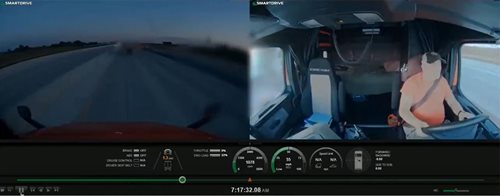
Sit at any diner in any truck stop and bring up inward-facing cameras and you will hear all kinds of opinions. While some believe it is a tool to help provide proof of innocence, others belief it is an invasion of privacy. The increasing use of these devices in our industry is not going to die down anytime soon. Here is my take.
What It Does
There are several types of inward-facing cameras. My company uses the Smart Drive system. It is actually an event recorder. An event such as an impact or a hard braking maneuver will create a file that is then transmitted to Smart Drive. The file is 10 seconds before the incident, the event, and 10 seconds after. These times can be expanded depending on what the company pays for. Smart Drive then analyzes the recording using all the data provided and if needed, sends it to my company. The company can then decide what to do with the recording.
The system we use is not capable of live streaming. There are some that are I assume, but I am not familiar with those. This will be about the event recorders that my company uses.
What It Sees
The outward-facing camera obviously sees the road. The inward-facing camera sees me and records audio. It also records speed, following distance, throttle, and brake usage. This gives the people looking at the video a pretty good picture of what was going on at the time of the incident or emergency.
There are some that feel this is an invasion of privacy, but I look at it this way. The vehicle I am driving is not mine. It is someone else’s. They are taking the financial responsibility for the vehicle and its cargo. They have every right to protect themselves financially in any way they see fit. In this time of nuclear verdicts, being able to prove one’s innocence without a doubt is really important. Just like having cameras in an office building or warehouse to protect and monitor the employees and equipment, inward-facing cameras provide the same protections for the company.
And for me.
In the event of a major accident, the company and the driver are usually sued. I don’t know about you, but I don’t have millions just sitting around to pay out. The inward-facing camera can help to prove my innocence in the case of one of those lawsuits. That camera can stare at me all day if it does that.
As far as the invasion of privacy at night, I can shut it off, cover it up, or simply close the curtains. My company is not taking away my right to privacy, I am voluntarily surrendering it while I operate their equipment, just like I voluntarily surrender it when I go to the mall, an amusement park, or even step out of my door and take a walk. I have a camera on my house that is motion activated and records everyone walking past my house or up my driveway. Many of my neighbors do too. There is no expectation of privacy in public.
Inward facing cameras are part of the requirements of employment. Nothing states that I have to work here. If I don’t agree with it I can seek employment elsewhere.
We have had drivers who were going to receive a ticket but didn’t because of the video provided. Not so surprisingly, they are fans of the inward-facing cameras now. I understand the discomfort of having a camera facing you all day. I am not trying to say you are wrong for feeling that way, I get it. But many times we complain that truck drivers are always found guilty because the police or the public just assumes we were being reckless or not paying attention. In my opinion, inward-facing cameras can help change that perception.
I’m good with that.